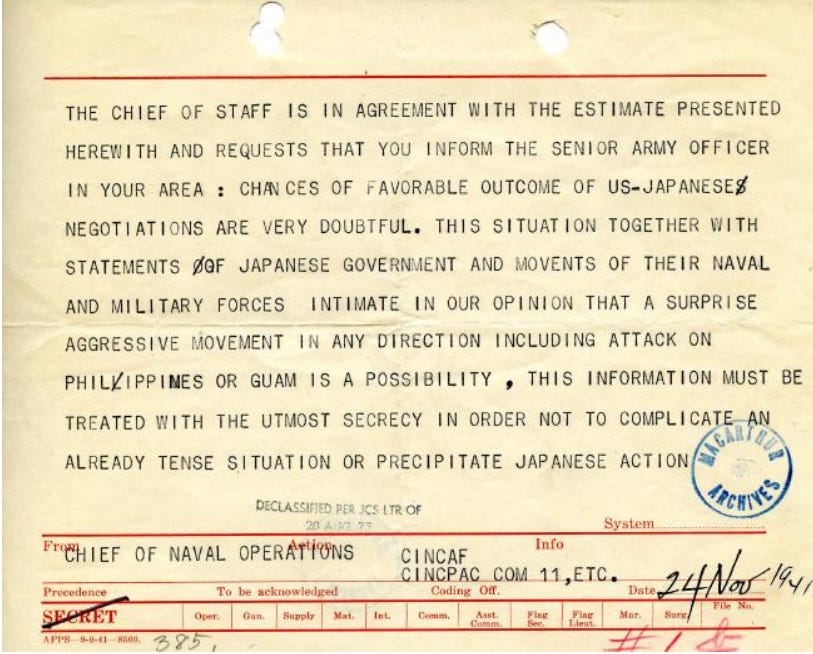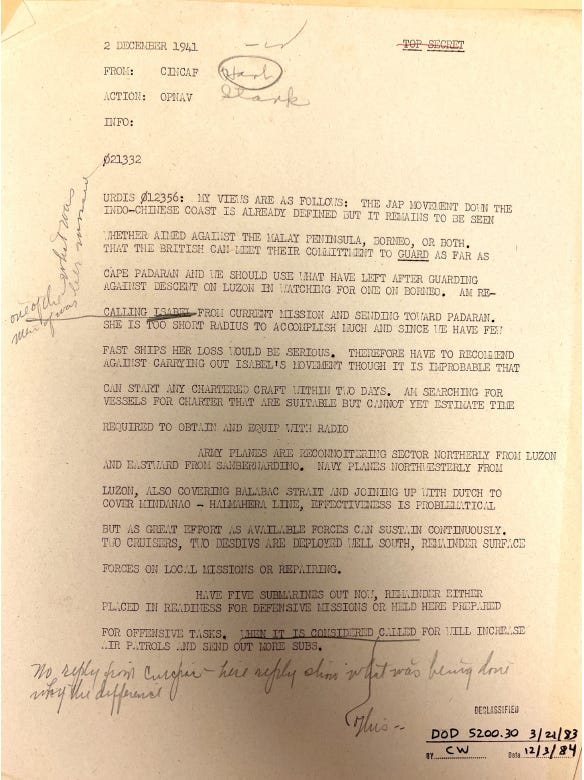Pearl Harbor: A Week Prior to the Pearl Attack, Admirals Discuss "Offensive" Against Jap Fleet on the Move
They Knew War was Imminent, and that Japan was About to Strike First
The U.S. Navy knew that a major Japanese fleet had left port on November 26, 1941. The Navy brass weren’t sure where it was headed.
The document below is a communication between Adm. Thomas Hart, the head of the then-U.S. Asiatic Fleet, based out of Manila in the Philippines, with Admiral Harold Stark, Chief of Naval Operations, a little less than a week prior to the Pearl Harbor attack.
They were internally discussing how and when to engage the Japanese fleet, and how war would proceed. Here’s the key discussion point at the end of the memo from Hart in the field to Stark in Washington: “Have five submarines out now, remainder either placed in readiness for defensive missions or held here prepared for offensive tasks."
“Offensive tasks” is a euphemism for war with the Japanese fleet.
This is a little less than a week prior to the Pearl Harbor attack.
They were actively trying to find and track the Japanese fleet, because they understood that the U.S. and Japan were both on a war footing and conflict was imminent.
Here is where in the memo Admiral Hart discusses trying to send out continuous reconnaissance in order to find the IJN fleet.
Not only does this clash with the official lie that Japan’s attack was a surprise, or that diplomacy was underway, it also shows that the military, specifically here the Navy, knew that Japan was preparing for a significant offensive operation.
Paraphrasing from other memos elsewhere, the position of those in the know was that the “time for diplomacy was over.” They knew war was coming at any moment, and it was coming in the form of this IJN fleet. They knew Japan was about to act and would be the first mover. They knew that they were likely to use a sneak attack.
When FDR said in his infamous “Day of Infamy” speech that:
The United States was “looking toward the maintenance of peace in the Pacific”
The Japanese had given “no threat or hint of war or of armed attack”
”Japan has, therefore, undertaken a surprise offensive extending throughout the Pacific area”
These were Roosevelt’s lies. Roosevelt was stalling to get Japan to attack first. He was “babying them along” with diplomacy until they would strike.
It worked, they struck, and the attack cost many young sailors their lives in horrible ways.
Pearl Harbor was the most dramatic attack, but a series of attacks in Southeast Asia proceeded from that opening to the war.
I posted a map below to show the wide variety of attacks the Japanese launched in December after Pearl Harbor. One of the most significant for the United States was the attack upon the Philippines. That battle has been somewhat forgotten by modern history, but started 8 hours after the attack on Pearl and ended with what is considered one of the worst defeats in American history.
Both Admiral Hart and Admiral Kimmel were given a general warning on November 24, 1941 that diplomacy with the Japanese would likely fail and that a surprise attack was likely. The naval movements being noticed in the 12/2/41 Hart to Stark communication indicate that prophecy was coming true. Here’s the 11/24/41 earlier warning dispatch from the Chief of Naval Operations Harold Stark to Admirals Hart and Kimmel from the MacArthur archives:
What these documents do not show, is that they knew there was a pending attack against Pearl Harbor.
Notably, Adm. Hart’s son-in-law was Francis Sayre Jr., the son of the then-head of the State Department’s Bureau of Far Eastern Affairs. Francis Sayre Sr. was, himself, the son-in-law of former President Woodrow Wilson. This means that one family was directly connected to both the Admiral overseeing the Naval fleet closest to the Japanese threat, and were also coordinating the diplomacy related to that impending conflict.

As Admirals Hart and Stark were planning how to engage the IJN fleet, one thing they did not do was to warn Admiral Kimmel of the Pacific Fleet at Pearl that there was a rogue Jap fleet marauding around looking for a war to start. They did not share with Kimmel that there was a Jap fleet looking for targets and his fleet might be necessary to back up the poorly-equipped Asiatic Fleet.
This document from December 2, 1941, declassified 43 years later in 1984, is in Box 10, Folder 7, of the Homer Ferguson files at the University of Michigan’s Bentley Library.
Even though the document says December 2nd, it is probably December 1st in America because of the international date line. The acronyms CINCAF and OPNAV stand for “CINCAF: Commander in Chief Asiatic Fleet” and “OPNAV: Chief of Naval Operations.”
Here’s the map of the Japanese attacks in Southeast Asia after Pearl Harbor, in December 1941.
So in our taxonomy of ‘advance knowledge’ claims about the Pearl Harbor attack, these documents show:
Desire for War. The US was taking steps to cause a war.
First Mover. The US knew the Japanese would attack first.
Sneak Attack. The US knew the attack would be a surprise.
Politica | PEARL HARBOR SERIES:
Pt 10 - Fr. Aloysius Schmitt & John Austin aboard the sinking USS Oklahoma
Pt 9 - Weak Leads-- Pearl Military Judge Drafts Martial Law Before Attack
Pt 8 - Reporter Tells US Japs Will Attack After Midnight on Dec. 6th
Pt 7 - Toward a Taxonomy of Claims about “Advance Knowledge” of the Attack
Pt 6 - Japs Were Trying to Escape Panama on Dec. 2nd
Pt 5 - Yes, there was Warning of the Pearl Harbor Attack
Pt 4 - ‘Very Bitter’ Housewife in ‘45 Notes Flaws in the Official Story
Pt 3 - Lloyd’s of London Cancelled Insurance Policies in August 1941
Pt 2 - Tips About The Pearl Harbor Attack 77 Years Late
Pt 1 - Pearl Harbor Revisionism










